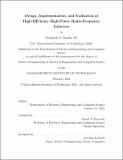| dc.contributor.advisor | David J. Perreault. | en_US |
| dc.contributor.author | Bayliss, Roderick S.,III. | en_US |
| dc.contributor.other | Massachusetts Institute of Technology. Department of Electrical Engineering and Computer Science. | en_US |
| dc.date.accessioned | 2021-05-24T19:40:11Z | |
| dc.date.available | 2021-05-24T19:40:11Z | |
| dc.date.copyright | 2021 | en_US |
| dc.date.issued | 2021 | en_US |
| dc.identifier.uri | https://hdl.handle.net/1721.1/130679 | |
| dc.description | Thesis: M. Eng., Massachusetts Institute of Technology, Department of Electrical Engineering and Computer Science, February, 2021 | en_US |
| dc.description | Cataloged from the official PDF of thesis. | en_US |
| dc.description | Includes bibliographical references (pages 111-112). | en_US |
| dc.description.abstract | Radio-Frequency (RF) power inductors are critical to many application spaces such as communications, RF food processing, heating, and plasma generation for semiconductor processing. Inductors for high frequency and high power (e.g., tens of MHz and hundreds of watts and above) have traditionally been implemented as air-core solenoids to avoid high-frequency core loss. These designs have more turns than magnetic-core inductors and thus high copper loss; their high loss and large size are both major contributors to the overall system efficiency and size. One contribution of this thesis is a magnetic-core inductor design approach that leverages NiZn ferrites with low loss at RF, distributed gaps and field balancing to achieve improved performance at tens of MHz and at hundreds of watts and above. This approach is demonstrated in a 13.56 MHz, 580 nH, 80 A[subscript pk] magnetic-core inductor design that achieves a quality factor of > 1100, a significant improvement over Q~600 achieved by conventional air-core inductors of similar volume and power rating. This thesis additionally describes the difficulties in experimentally measuring inductor quality factors with very high current and very low loss at very high frequency. Several measurement techniques are proposed and evaluated to enable consistent measurement of inductor resistance at these operating points. Finally, these design techniques are extended to an inductor design which achieves "self-shielding" in which the magnetic field generated by the element is wholly contained within the physical volume of the structure rather than extending into space as a conventional air-core inductor would. This development enables significant reductions of system enclosure volume and improvements in overall system efficiency. | en_US |
| dc.description.statementofresponsibility | by Roderick S. Bayliss III. | en_US |
| dc.format.extent | 112 pages | en_US |
| dc.language.iso | eng | en_US |
| dc.publisher | Massachusetts Institute of Technology | en_US |
| dc.rights | MIT theses may be protected by copyright. Please reuse MIT thesis content according to the MIT Libraries Permissions Policy, which is available through the URL provided. | en_US |
| dc.rights.uri | http://dspace.mit.edu/handle/1721.1/7582 | en_US |
| dc.subject | Electrical Engineering and Computer Science. | en_US |
| dc.title | Design, implementation, and evaluation of high-efficiency high-power radio-frequency inductors | en_US |
| dc.type | Thesis | en_US |
| dc.description.degree | M. Eng. | en_US |
| dc.contributor.department | Massachusetts Institute of Technology. Department of Electrical Engineering and Computer Science | en_US |
| dc.identifier.oclc | 1251773201 | en_US |
| dc.description.collection | M.Eng. Massachusetts Institute of Technology, Department of Electrical Engineering and Computer Science | en_US |
| dspace.imported | 2021-05-24T19:40:11Z | en_US |
| mit.thesis.degree | Master | en_US |
| mit.thesis.department | EECS | en_US |
